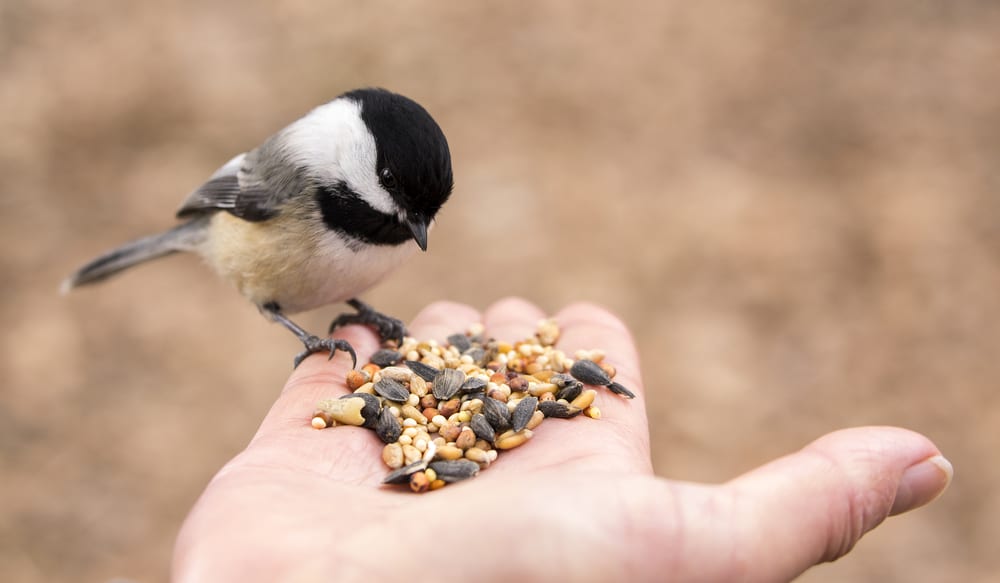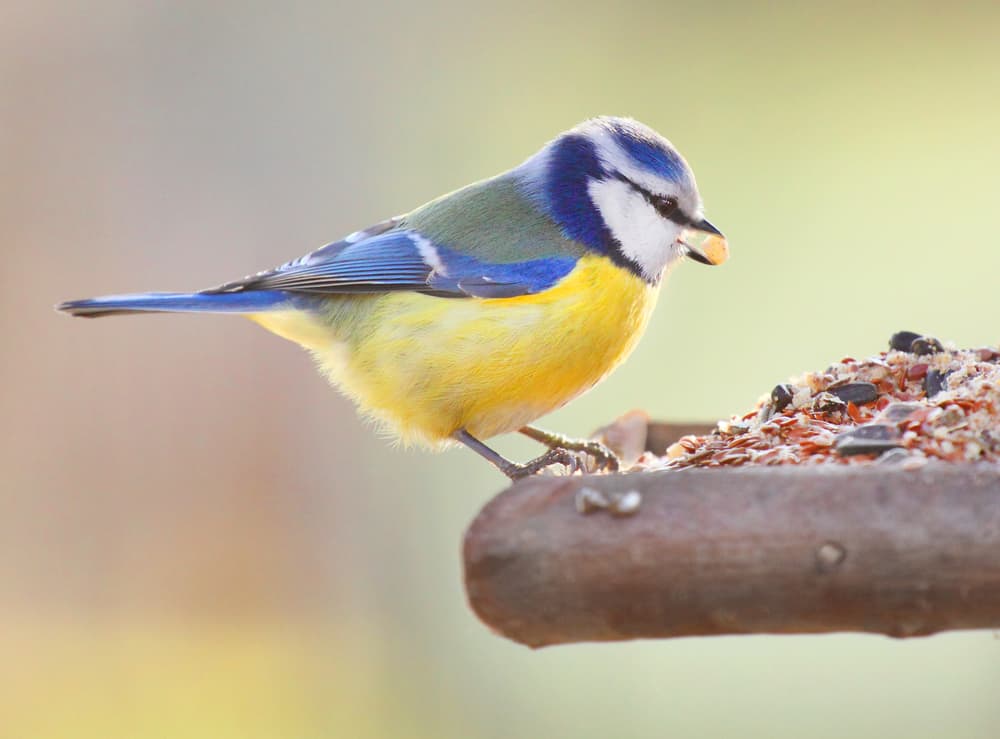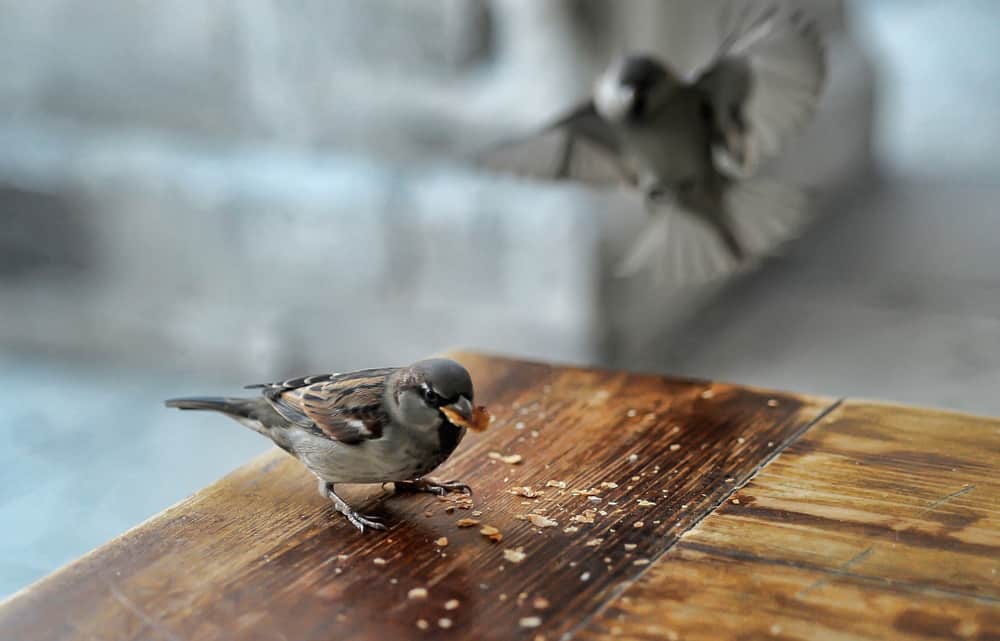Not all birds are fed in the same way and with the same food. What do birds eat depends on what species they belong to, the climate where they live, and the season.
Most birds feed on insects, seeds, fruits, and berries. Those that don’t migrate feed on fruit and seeds in winter. On the other hand, they prefer consuming insects in spring and summer they can find in nature in that period.
Birds Habits and Biology
Birds (Aves) are an animal group that stands out from other species by their ability to fly. They are dinosaur’s descendants with uniquely structured spindle-shaped bodies that provide the least resistance during the flight.
The birds’ body size is very different. Thus, a large African Ostrich can reach up to 10 feet (3 m) in height and weigh about 297.5 pounds (135 kg).
On the other hand, Helen’s Hummingbird from Cuba is the smallest bird on the planet, with a length of about 2.5 inches (6 cm). It weighs only up to 0.055 pounds (2.5 g).
As for the bird’s speed, various factors affect it, such as the wind and flight angle. Wildlife photographer and conservationist John H. Storer studied the bird’s aerodynamics. He came to crucial information about this matter.
Bird speed |
|
| Bird | mph (km/h) |
| Great blue heron | 0 to 36 mph (0 – 58 km/h) |
| Osprey | 0 to 60 mph (0 – 96.5 km/h) |
| Pheasant | 0 to 60 mph (0 – 96.5 km/h) |
| Woodcock | 0.5 to 13 mph (0.8 – 21 km/h) |
| Sharp-shinned hawk | 16 to 60 mph (26 – 96.5 km/h) |
| Barn Swallow | 20 to 46 mph (32 – 74 km/h) |
| Crow | 25 to 60 mph (40 – 96.5 km/h) |
| Falcon | 40 to 48 mph (64.5 – 77 km/h) |
| Ruby-throated hummingbird | 45 to 55 mph (72.5 – 88.5 km/h) |
| Canada goose | 45 to 60 mph (72.5 – 96.5 km/h) |
| Mallard | 55 to 60 mph (88.5 – 96.5 km/h) |
| Duck Hawk | 175 to 180 mph (281.5 – 290 km/h) |
Birds are present on all continents, from the warmest African deserts to Antarctica. While some species spend their lives in one place, other bird species migrate between continents due to cold and reproduction.
Typically, birds choose different habitats, depending on their species. For instance, the albatross spends its life on the high seas, except during the nesting season. In contrast, seagulls live near the seashore. Some species use cavities in trees for nesting, while others make their nests on the ground, chimney tops, or in bushes.
Additionally, prey birds usually live and hunt alone, while some species live in flocks. Some will separate during the mating season, while others live permanently in flock formation. Basically, the only rule is, there are no rules at all.
Do Birds Eat Dirt?
The answer to whether birds eat dirt can be yes, but not all birds species do such a thing. Only birds that live in areas without enough food rich in sodium eat dirt, like parrots in the Amazon rainforest.
Since there is a lack of sodium in food in the western Amazon, birds often eat dirt to make up for it. This unusual habit also helps parrots in detoxification after consuming poisonous or harmful food. You will probably see your pet parrot doing it as an instinctive behavior.
What Do Birds Like to Eat Most
Most birds eat food that includes different insects, plants and seeds, nuts, berries, and fruits. Predatory birds eat small animals, such as rodents and snakes. In essence, their diet depends on the bird type and the season. However, it seems that most birds like to consume:
Safflower seeds
It is a delightful option for winter feeding birds because it is rich in carbs, fat, and proteins. These seeds are a favorite food for:
- Jays
- Sparrows
- Cardinals
- Finches
- Doves
Nyjer seeds
Most birds can eat these seeds full of oil, soluble sugars, and proteins, regardless of the season. Some species prefer eating them, like:
Peeled sunflower seeds
They are rich in fat, so you need to limit the amount your pet should eat. Birds that love this food type are:
- Doves
- Woodpeckers
- Sparrows
- Finches
Black-oil sunflower seeds
They are rich in vitamins B and E, potassium, calcium, and iron, making them the best choice for the winter and nesting seasons. They have a thin shell and open easily, so they are the following bird types favorite food:
- Magpies
- Blackbird
- Doves
- Finches
- Northern Cardinals
Cracked corn
This food doesn’t have much fat but is rich in protein and fiber. Most birds don’t like it too much, but some species enjoy eating it, including:
- Pheasants
- Doves
- Cardinals
- Jays
- Ducks
- Ravens
- Crows
- Quail
Milo
It is a grass grain type rich in carbohydrates. There are not many species of birds that prefer this food, but some love it:
- Starlings
- Doves
- Cowbirds
- Grackles
Nectar
It is not a food in itself that can satisfy any bird species’ nutritional needs. However, some species consume them as a treat:
- Honeyeaters
- Hummingbirds
- Sunbirds
Fruit
Many bird species enjoy fruit and fruit products, like jam and jelly. For instance, grape jelly is a favorite food for:
- Orioles
- Tanagers
- Woodpeckers
However, you need to be careful with this option because fruit contains a high sugar amount. Too much sugar can lead to health problems in most birds.
Suet
Ball-shaped or tile-shaped cattle and sheep fat is the best food in autumn or winter when birds need more energy to maintain body heat. It is favorite for:
- Woodpeckers
- Starlings
- Goldfinch
- Wrens
- Jays
Mealworms
Mealworms are rich in protein. So, they can provide birds with enough energy. Here are some species that like to eat them the most:
- Sparrows
- Wrens
- Robins
- Starlings
- Blackbirds
Food Avoid to Feed Birds
Although you adore your bird pet and want to share your meal with it, certain foods you like to eat are not the right option for it, including:
Avocado
These vegetables’ leaves contain the fungicidal toxin person that causes breath shortness, weakness, heart damage, and sudden death in birds within a day or two.
Onion and garlic
These veggies are poisonous to many animals, including birds. They contain sulfur compounds (onion) and allicin (garlic), which can cause anemia and heart failure in birds.
Fruit pits and apple seeds
Apple seeds and cherries, apricots, plums, and peaches pits contain a small amount of cyanide toxic to the bird’s heart. Therefore, you should clean those fruit of pits and seeds before offering them to your pet.
Alcohol
It can be fatal to your pet, so it shouldn’t be readily available.
Caffeine
It is an ingredient in coffee, tea, and soft drinks you shouldn’t share with your bird. Caffeine can cause heart problems in these animals, including:
- Arrhythmia
- Heart failure
- Hyperactivity
Chocolate
It contains theobromine and caffeine and can be toxic to your feathered pet. These ingredients cause:
- Vomiting and diarrhea
- Hyperactivity
- Trembling
- Increased heart rate
Since these symptoms indicate central nervous system involvement, this condition can even lead to death.
Xylitol
It is an artificial sweetener found in many dietary products. Although scientists have not sufficiently studied its effect on birds, it is better to avoid products with xylitol in their diet since birds have a faster metabolism than other animals.
Salt
It adversely affects the electrolyte balance in the bird’s tiny body. It causes dehydration and kidney failure, which can lead to your pet’s death.
Fat
It can endanger the bird’s life after accumulating in its body, often causing heart disease and stroke.
Other food
You can offer some ingredients occasionally to your bird, but you should avoid doing that daily:
- Peanuts
- Milk
- Mushrooms
- Bread and cookies
Tips to Feed Birds
Your backyard coverage with plants, trees, and shrubs, should provide:
- Security for birds during the nesting period
- Shelter from natural disasters
- A place to hide from predators
To attract birds to feed in your yard or garden, you need to provide three things:
- Quality and varied food
- Fresh and clean water for drinking and bathing
- Enough vegetation to hide and nest
There are different bird feeders types. Some birds species prefer feeding on branches, while others choose the ground.
Once you set up the feeders, it will be some time before the birds accept the new territory. Constantly full feeders and containers with fresh and clean water ensure that the birds settle in your garden or yard.
The best time to start feeding is autumn and winter. Then the food decreases availability in nature, so your feeder will be a welcome replacement. By the time the warm days arrive, the birds will already be getting used to the food in your yard and will keep coming.
In addition to the feeder, it is desirable to place containers with drinking water. The best option is to put both food and fresh water in the same place.
Summary
Different birds species eat various food, but it needs to be fresh and quality. Whether you feed your bird in the backyard or as a pet, the food should never adversely affect its health.


